The 11th Five-year Plan - A Report Card

As central government and high-level party committees issued drafts of the 12th Five-year Plan in late October, journalists from the EO's News Department decided to evaluate the performance of several important central ministries against the targets and strategic goals they were set as part of the previous five-year programme which covered the period from 2006 to 2010.
The architects of China's 11th Five-year plan actually made a deliberate point of switcing the name of the economic guidlines from the former term "plan" (计划 jìhuà) to the softer sounding "guidleines" or "program" (规划 guīhuà) when they drafted the eleventh Five-year Program (十一个五年规划) in 2005. They were aiming to move away from the associations with state planning and hard production targets that the earlier Five-year Plans had towards establishing a softer, longer-range programme or strategy. The new terminology has been maintained for the coming 12th Five-year Program (十二个五年规划). Despite this official change in terminology, the phrase Five-year Plan has remained in common usage in English-language reports. In the following feature we have continued to refer to both the 11th and 12th Five-year Plans.
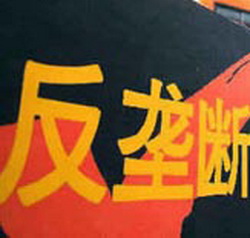 Monopolies are Blocking the Path to Reform
Monopolies are Blocking the Path to Reform
By Zhang Xiandong
News, Page 5
Issue 491, October 25, 2010
Translated by Leslie Walczak
Original article: [Chinese]
Four years ago, the National Development and Reform Commission (NDRC) issued a 16,000-character program that attempted to map China's economic development through to the year 2010. The 11th Five-year Plan identified fourteen economic targets, eight of which were binding. As the deadline for reaching these targets approaches, the question of whether the country will meet all of these goals is worth investigating.
Of the 14 proposed targets, the primary objectives were annual GDP growth of 7.5 percent, annual per capita GDP growth of 6.6 percent and average income growth of 5 percent. In 2008, Zhang Ping, the head of the NDRC, announced a midterm assessment of the 11th Five-year Plan. The assessment found that along with the desired rate of urbanization, three other indicators were also below expectations, namely: increasing the proportion of value-added services by 3 percent over 5 years, increading the number of people employed in the service industry in proportion to total employment by 4 percent and increasing the portion of domestic GDP dedicated to research expenditure. The other ten indicators were found to either be on target or even exceeding expectations.
Ren Wangbing, director of the service industry office at the Academy for Macroeconomic Research's (a think tank under the NDRC) Institute of Industrial and Technological Economics Research, told the Economic Observer that nearly every Five-year Plan will have one or two targets that are not reached - the targets set in relation to development of the country's service industry appears to be one of the missed targets this time around.
Professor Ren argues that in order for China's service industry to achieve rapid growth, monopolies have to be broken up.
In fact, the breaking up of monopolies will not only lead to the development of China's service industry - it's also of fundamental importance to the development of the domestic petrochemical, telecommunications, energy, salt, tobacco and several other industries. Breaking up the monopolies will also impact on reforms to China's system of investment, be critical to the expansion of private investment and at the same time it's already at the heart of efforts to reform the distribution of income. All these factors will finally determine the direction of China's economic development.
Throughout the period of the 11th Five-year Plan, the NDRC has repeatedly emphasized the importance of eliminating monopolies in order to push ahead with the development of the service industry. However, little progress has been made. The salt industry has been mulling organizational reform for three years, but thus far there is little sign of progress. A shake-up of China's energy sector has faced even more difficulties getting off the ground.
The 11th Five-year Plan also stated that more efforts would be made to speed up the separation of electrical power distribution networks, to encourage the construction of regional power markets, continue to expand pilot programs that encourage large energy consumers to trade directly with energy producers and also gradually separate out energy distribution from transmission. However, energy network analyst Han Xiaoping says that over these past five years, China's energy industry has not made the slightest progress in regards to reorganization of the current system, and in fact, it appears to have regressed in some areas. The same is true of the petroleum industry where the private sector is still in the same old position of being a "bit player."
Despite the 11th Five-year Plan's focus on income distribution reform, progress is still restricted by the presence of industrial monopolies. Although the income growth rate of Chinese citizens has persistently increased and the stated per capita target of 5 percent annual income growth will probably be attained, it is a widely recognised that the disparity between the incomes of rural and urban residents continues to grow.
Monopolies have also made it difficult to make progress with price reforms outlined in the plan. The 11th Five-year Plan proposed that China would progressively restructure the system for setting prices for refined oil products, would increase the flexibility of natural gas prices and possibly introduce preferential pricing for renewable energy. However, Han Xiaoping told the EO that every step of the recent energy industry reforms have been based on the result of negotiations between the government and a few monopoly enterprises.
On April 28 this year, when the State Council passed "Ideas on Important Work for the Deepening of Systemic Economic Reform in 2010," they emphasized three crucial areas: the need to rapidly reform monopoly enterprises, price reform and income distribution reform. The State Council said that these three reforms not only determine whether the goals set as part of the 11th Five-year Plan will be met, but may also affect the smooth implementation of the 12th Five-year Plan.
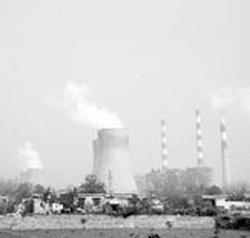 Ministry of Environmental Protection
Ministry of Environmental Protection
By Yu Huapeng
News, Page 5
Issue 491, October 25, 2010
Translated by Leslie Walczak
Original article: [Chinese]
The 11th Five-year Plan contains three types of binding emissions reduction targets. The first is a target of reducing energy consumption by 20 percent per unit of GDP, the second and third are to reduce sulfur and chemical oxygen demand (COD) emissions by 10 percent each. In 2009, COD emissions dropped by 9.66 percent and sulfur emissions fell by 13.14 percent. It is estimated that an additional 75,000 tons of COD emissions can be eliminated by the end of 2010, meaning that the COD target will also be met.
Over the first four years of the 11th Five-year Plan, the entire country has phased out more than 6,000 million kilowatts worth of small thermal power units and other outdated and heavily polluting industrial facilities. However, energy efficiency contributes only 30 to 40 percent to total energy-savings, more energy-saving technology is needed.
By the end of 2009, energy consumption per unit of economic output was down by only 15.61 percent, with further reductions of only 3-5 percent anticipated for 2010. Currently, there are a few provinces that have already exceeded their energy efficiency targets, there are another 18 provinces that are on track to meet their goals - but there are also 5 or 6 provinces that face difficulties in meeting their targets.
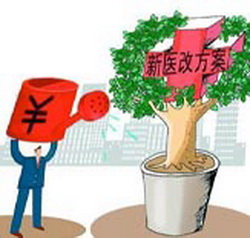 Ministry of Health
Ministry of Health
By Wen Shuping
News, Page 5
Issue 491, October 25, 2010
Translated by Leslie Walczak
Original article: [Chinese]
In the last year, the Ministry of Health was finally able to achieve its goal of lowering drug prices. Following the introduction of a generic drugs list, average drug prices have decreased by between 25 and 50 percent. However, in regards to the 11th Five-year Plan's goal of resolving the financial difficulties that ordinary people confront when seeking medical treatment, the price of medicine accounts for just one small part of the problem. Following the reforms to the medical sector in the 1980s, hospitals were pushed to adapt to a market environment. Now cash flows are autonomously managed, government subsidies have been removed and hospitals have become accustomed to earning money in order to sustain themselves. The price of medical treatment has rapidly increased, making it very difficult for ordinary people to afford treatment at a hospital.
The 11th Five-year Plan not only focused on reforming the country's pharmaceutical pricing system, but also required the government to invest more in public medical facilities and to open up drug contracts to competitive bidding. The ministry cancelled the 15 percent margin that hospitals were charging on top of the wholesale price of drugs and also started providing subsidies to the hospitals for the subsequent loss in revenue - gradually shifting away from a model which saw profits from the sales of medicine act as a major source of income for hospitals. All of these recently-introduced policies have the potential to reduce the aggregate amount spent on drugs by ordinary people nationwide by nearly 70 billion yuan. Medical reforms over the past 5 years have required all levels of government to invest a total of 850 billion yuan, 331.8 billion of which comes from the central government coffers. However, due to a lack of fiscal revenue in some areas, local government contributions have not always been forthcoming. Although ordinary people are now starting to realize the benefits of lower drug prices, whether these lower prices can be maintained is yet to be seen.
 Department of Housing
Department of Housing
By Song Yao
News, Page 5
Issue 491, October 25, 2010
Translated by Leslie Walczak
Original article: [Chinese]
According to the 11th Five-year Plan, an average of between 500 and 600 million square meters of newly constructed residential housing would be built in cities and towns across China every year. However, nationwide sales of commercial housing reached 760 million square meters in 2007, fell to around 600 million square meters in 2008 and then peaked at 937 million square meters in 2009. The large discrepancy between the amount of new residential housing planned and the amount of sales caused a disparity between supply and demand and the market has interpreted this disparity as the fundamental reason behind soaring prices witnessed over recent years.
In view of this, some of the housing construction sector's projects exceeded what was planned - the construction of affordable housing being one example. The 11th Five-year Plan required that affordable make up between 15 and 20 percent of the total amount of residential floor space constructed every year. However, in the past two years affordable housing construction has far exceeded this quota. If the Department of Housing continues to comply with its mission, new affordable housing will reach 168 million square meters in 2010 and 253 million square meters in 2011.
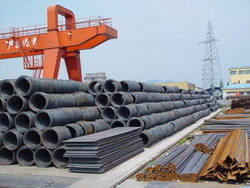 Ministry of Industry and Information Technology
Ministry of Industry and Information Technology
By Zhang Xiangdong
News, Page 6
Issue 491, October 25, 2010
Translated by Leslie Walczak
Original article: [Chinese]
Industrial goals of the 11th Five-year Plan included, but were not limited to, adjusting the structure and composition of the raw materials industry, reducing energy consumption, improving product quality and revitalizing the equipment manufacturing industry. The Ministry of Industry and Information Technology's (MIIT) data shows that during the entire 11th Five-year Plan period, structural improvements were significant. For example, since 2005, China's iron and steel industry has unceasingly improved the variety and quality of its goods. Data shows that in 2005, Chinese-made steel accounted for 92 percent of the domestic market and by 2009, market share had already risen to 96 percent.
Of most concern in the market, is that the last five year's restructuring has accelerated market concentration. MIIT data shows that in 2005, China's top ten steel producers accounted for 35.4 percent of the country;s entire steel output. However, by 2009, the top ten steel companies accounted for 43.5 percent of national output. MIIT added that in 2010, anticipated mergers and reorganization of various large steel firms will increase the level of market concentration. However, according to industry insiders, not all merger deals go as well as planned. Other issues warranting concern include industrial upgrading, China still cannot produce high-end automotive sheet metals and its production of high value-added products is still small.
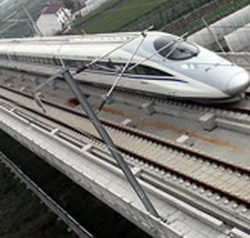 Ministry of Railways
Ministry of Railways
By Wen Shuping
News, Page 6
Issue 491, October 25, 2010
Translated by Leslie Walczak
Original article: [Chinese]
The 11th Five-year Plan allocated 1.25 trillion yuan for railroad infrastructure construction and set a goal of managing over 90,000 km of operational tracks by 2010. The implementation of the 2008 stimulus plan sped up railway construction considerably. By the end of 2009, nationwide investment in railways had already reached 2.1 trillion yuan. In addition, a further 823.5 billion yuan was invested in 2010, lifting the total investment over the course of the 5 years to nearly 3 trillion yuan and the target of 90,000 km of track was achieved. The construction of high-speed rail lines has depended on debt financing. A study by the Audit Commission of Foreign Loans and Assistance found the Ministry of Railways had racked up a debt of about 1.3 trillion yuan in 2009.
At the end of 2007, the Ministry of Railways total debt was roughly 658.706 billion yuan, meaning that debt had grown by 97.9 percent over the past two years. The Ministry of Railways long-term plan is for the nationwide railway mileage to reach 110,000 km or more by 2012 and 120,000 km, or more, by 2020. With further railroad construction, research organizations predict that the Ministry of Railways will continue to incur debt. These organizations also believe that the Ministry of Railways will establish asset management companies in order to deal with this rising debt burden.
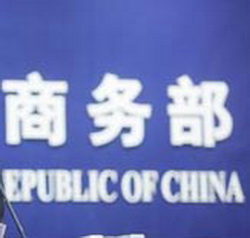 Ministry of Commerce
Ministry of Commerce
By Zhang Bin
News, Page 6
Issue 491, October 25, 2010
Translated by Leslie Walczak
Original article: [Chinese]
The Ministry of Commerce has essentially achieved the targets it was set five years ago as part of the 11th Five-year Plan. In 2009, China's total retail sales of consumer goods reached 13.3 trillion yuan. This year, total sales are expected to be double those of 2005. In fact, growth in sales of domestic consumer goods has actually exceeded the 11th Five-year Plan's target by 11 percent. In 2009, China became the second largest commodity trader in the world. Additionally, having achieved the 11th Five-year Plan's goal of 2.3 trillion U.S. dollars in exports, China became the top exporter in the world this year. At the same time, effective use of foreign capital also improved significantly. Foreign direct investment (FDI) is expected to reach 420 billion U.S. dollars by the end of this year. This 150 percent increase in the amount of investment that China is attracting has led China to become number two in the world rankings of country's attracting FDI.
Much progress was also made in relation to the goal of "Going Out" (走出去 zǒu chūqù). China has directly invested over 200 billion U.S. dollars abroad, an average growth rate of approximately 30 percent. During the 11th Five-year period, China has actively expanded bilateral trade relationships, accelerated the implementation of free trade zones and has unceasingly intensified multilateral trade cooperation. The plan's stated mission has been completed, but progress is still inadequate. As average annual export growth was roughly 10 percent higher than what was expected, the goal of achieving a balance between imports and exports was not realized. The export structure needs further optimization and, while use of foreign investment goals have been achieved in terms of quantity, further improvements are needed in order to achieve quality-related goals.
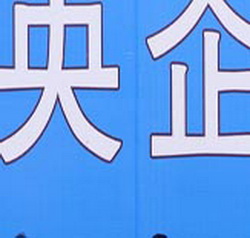 Centrally-owned Enterprises and SASAC
Centrally-owned Enterprises and SASAC
By Kang Yi
News, Page 6
Issue 491, October 25, 2010
Translated by Leslie Walczak
Original article: [Chinese]
12.63 trillion yuan in revenue; 815.1 billion yuan in profits.
Behind these numbers is five years of state-owned assets management reforms. To borrow the official wording, the achievements of these reforms can be summarized in the following way: a framework for state-owned assets regulatory system has been established, mechanisms for supervising investments have been strengthened, a new, more modern mechanism for acquiring and appointing personnel has been established, corporate governance structures have been continuously improved and the transfer of state-owned assets has been further standardized.
Impressive Numbers
By looking at the data, it can be said that China's reform of state-owned enterprises is headed in the right direction. From 2002 to 2009, the total assets of centrally-owned enterprises increased from 7.13 trillion yuan to 21 trillion yuan, or by an average of 16.74 percent annually. Operating income increased by an average of 20.8 percent annually and profit increased to 815.1 billion yuan from 240.5 billion yuan, an average increase of 19 percent annually.
Simultaneously, the reorganization and integration of state-owned enterprises also made progress. Since the beginning of 2003, the number of companies under the control of the State-owned Assets Supervision and Administration Commission (SASAC) decreased from 196 to 122. The company structure of enterprises under SASAC's supervision has also improved; by the end of 2010, 32 of them will have established a board of directors.
Bright Spots of the Reform Plan
The system for having COE and other state-owned companies contribute to government coffers has also made substantial progress. In 2007, the government issued new regulations that brought to an end the era that had existed since 1994 which allowed COEs to simply pay taxes and avoid any commitment to submit dividends to the central government. Another bright spot is imminent establishment of an additional asset management company (Guoxin Asset Management or CIC No. 2). According to SACAC's plan, Guoxin will serve to promote reform and accomplish structural adjustment.
SACAC's efforts to encourage corporate governance restructuring, namely the establishment of boards of directors, deserves closer attention. The adoption of boards of directors serves four purposes: first, it safeguards the interests of investors; second, it improves decision making by providing a collective pool of wisdom and authority; third, it creates a system of internal checks and balances; fourth, it establishes a "safety valve", helping to settle major lapses in strategic decision making.
During the 11th Five-year Plan period, SACAC promoted the streamlining of large state-owned companies by encouraging central enterprises to focus on their main industries rather than their non-core business investments.
The Next Stage of Reforms
Zhang Wenkui , head of the State Council's Development Research Center, recently urged the central government to push ahead with a new round of reforms of state-owned enterprises. The goal of these reforms should be privatization, thus shrinking the size of the state-owned economy. The timeline for these reforms should be five years.
This feature was edited by Paul Pennay
Links and Sources
The Economic Observer: Special Feature (Chinese)
NDRC: The 11th Five-Year Plan: targets, paths and policy orientation
The Economist: China's economy: A new epic
China Internet Information Center: Special Feature Covering the 1st to 10th Five-year Plans (Chinese)
The views posted here belong to the commentor, and are not representative of the Economic Observer |
Related Stories
Popular

- FIVE-YEAR PLAN
- The 11th Five-year Plan - A Report Card
- What stopped several central government departments from achieving their targets?
Interactive
Multimedia

- EEO.COM.CN The Economic Observer Online
- Bldg 7A, Xinghua Dongli, Dongcheng District
- Beijing 100013
- Phone: +86 (10) 6420 9024
- Copyright The Economic Observer Online 2001-2011
















